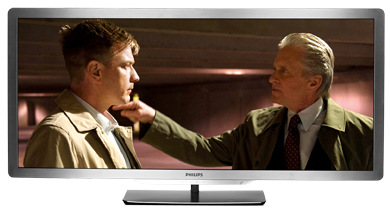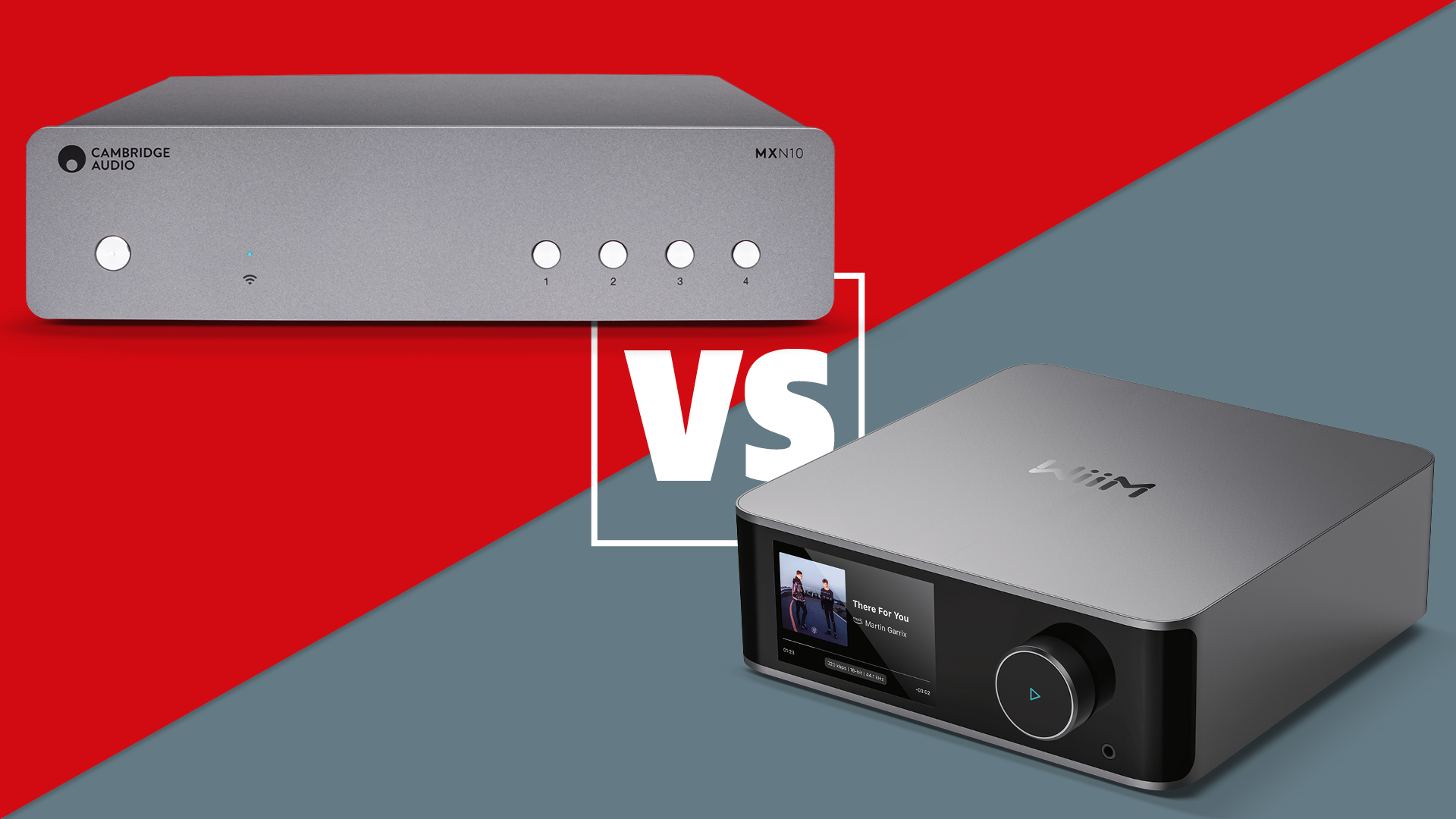What Hi-Fi? Verdict
We’re not exactly spoilt for 21:9 choice, but nevertheless this is the best implementation we’ve seen
Pros
- +
Physically impressive
- +
superb detail
- +
strong contrast
- +
‘Easy 3D’ is just that
Cons
- -
Ours had some backlight bleed
- -
not great for gamers
- -
iffy online picture quality
Why you can trust What Hi-Fi?
Philips is holding steady with its mega-wide Cinema 21:9 range of screens, despite the fact that competition is conspicuously absent,. The Dutch TV maker obviously has faith in its concept – and this 50PFL7956T model (informally dubbed ‘Gold series’) is its most affordable super-widescreen set yet.
No matter which telly you have, you’ll still have to put up with black bars at the top and bottom of the picture when you watch Blu-rays. That’s because the aspect ratio
of a film in the cinema isn’t the same as your 16:9 set – it’s much wider; 21:9, in fact.
Philips doesn’t believe in this kind
of compromise, though, which is why
its holding steady with its mega-wide Cinema 21:9 range of screens. Competition is conspicuously absent, but Philips obviously has faith in its concept – and
this 50PFL7956T (informally dubbed ‘Gold series’) is its most affordable effort yet.
The two curvy, slippery remote controls are plastic rather than the metal of its more expensive ‘Platinum Edition’ sibling, and
it uses a passive 3D system. The Ambilight feature Philips has been enamoured of
for so many years is here in just two, vertical, strips (left and right on the rear
of the panel). And, of course, it’s a smaller panel than its sibling, too – width-wise,
it doesn’t occupy much more space
than a conventional 40in 16:9 TV.
Well specified and great for tweakers
On the other hand, this 21:9 has some features its big brother goes without. It’ll convert 2D to 3D, for instance, and has
a Freeview HD tuner. And in any event,
it’s fairly well specified: there’s a suite of on-line options, including catch-up TV
and a web-browser, accessible via wired or wireless connection, while movies, photos and music can be accessed via DLNA.
There are two pairs of light, comfortable 3D glasses included, and at additional cost some ‘dual-play’ specs. This lets one viewer to see a completely different set of pixels to the other – so players of split-screen games can enjoy a whole screenful of information rather than half of a split screen.
As we’ve come to expect from Philips flatscreens, the 50PFL7956T is a tweaker’s delight. The menus are best characterised as ‘extensive’ – and with Philips’ Pixel Precise HD engine running the show, there’s a plethora of adjustability to be investigated before you can be sure the Philips is performing at its best. Still, perseverance brings rewards, and the set-up procedure isn’t interminable. It just feels like it.
Pictures from the Philips’ Freeview HD tuner are bright, high-contrast affairs. Even a daytime-TV staple like Cash in the Attic looks vibrant – no mean feat in itself – and given an authentically high-quality broadcast to deal with, the 50PFL7956T is capable of really impressive results. Contrasts are strong, detail levels are extremely high and motion is generally unflustered. Tricky movement can induce a little hesitancy, but on the whole this is a composed watch with the kind of hyper-
realism that only Philips seems capable of.
There’s a similar level of detail and insight on show with a switch to DVD. Upscaled images from a copy of Hanna include more picture noise than we’d like (which we reckon is the trade-off for the prodigious levels of detail on show), and there are undoubted issues with motion, but contrast, skin-tones and –textures,
and apparent depth of field all impress.
At the top of the quality shop, Blu-ray images look an absolute treat. Our copy of War Horse revels in extensive, clean and detailed contrasts between black and white tones, and offers greater overall levels of detail than any similarly priced TV we’ve seen so far this year. Motion is handled confidently with all but the most maverick of camera moves, and the impression of depth the 50PFL7956T is capable of generating trounces even the best of its rivals. Picture noise is negligible, edges are crisp, and the colour palette is wide-ranging and natural. And, of course, the film is delivered in full, filling the screen with no black bars getting in the way (though the Philips is, of course, scaling the content of the disc to fit its 2560 x 1080 resolution).
We’ve been enjoying The Witcher 2 on the Xbox 360 lately, and played on the Philips it looks bright, colourful and superbly detailed. As a gamer’s TV it suffers a little from the cleverness of its own processing: there’s discernible button-lag when playing. With the tech switched off, though, motion gets more than a little shimmery and approximate. It’s possible
to effect a fairly workable compromise,
but at no point is the 50PFL7956T entirely happy with a console attached to it.
With our lightweight 3D glasses in place and a copy of TT3D: Closer to the Edge spinning in the player, the benefits of the Philips’ passive, ‘Easy 3D’ configuration are obvious. As we’ve seen when reviewing LG’s recent 3D TV offerings (the Korean giants are by far the most vocal advocates of passive 3D), watching 3D this way is gratifyingly easy on the eyes and eliminates flicker almost entirely. Yes, the resolution of 3D pictures is effectively halved compared with active-shutter sets, but the Philips generates such lavishly detailed images it’s scarcely an issue. Images are bright and colourful, motion is gripped tenaciously, and the 3D effect, undoubtedly aided by the Philips’ Ambilight-assisted facility with perceived depth, is pretty dramatic.
The company is claiming a total of 34W to drive the 50PFL7956T’s speakers, as well as referring to something called ‘incredible surround’ as one of its audio options. There’s no denying the expansive nature of this set’s sound, but it’s entirely lacking in presence below the midrange, and what information there is sounds rather weedy. Once again, we strongly suggest you try a soundbar as the very least you should to bolster the sound of your nice, new (and expensive, let’s not forget) television.
While we’re finding fault, we need to point out that our 50PFL7956T suffered from minor, but definite, backlight bleed
in its bottom-left and top-right corners.
It all-but disappeared when the screen was showing a picture, but at the very least it would mean a trip back to the retailers…
Fundamentally, this is a TV for those who watch a more-or-less exclusive diet of HD films. It’s a fine telly, of course, but there’s little enjoyment to be had in watching your soaps with black bars to the left and right of the picture. It’s almost indecently satisfying for watching movies, though – and, let’s face it, it’s a pretty cool bit of décor, too.
The two curvy, slippery remote controls are plastic rather than the metal of its more expensive Philips 58PFL9955H ‘Platinum Edition’ sibling, and it uses a passive 3D system rather than the active-shutter type.
The Ambilight feature Philips has been enamoured of for so many years is here in just two, vertical, strips (left and right on the rear of the panel).
And, of course, it’s a smaller panel than its 58in sibling, too – width-wise, it doesn’t occupy much more space than a conventional 40in 16:9 TV.
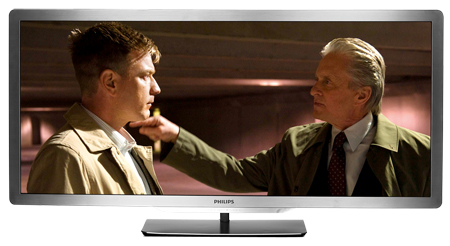
Philips 50PFL7965T: Tech specs
On the other hand, this 21:9 has some features its big brother goes without. It’ll convert 2D to 3D, for instance, and has a Freeview HD tuner.
And in any event, it’s fairly well specified: there’s a suite of on-line options, including catch-up TV and a web-browser, accessible via wired or wireless connection, while movies, photos and music can be accessed via DLNA.
As for online services, the Philips is definitely in the 'good-rather-than-great' category. There's not shortage of content – some folk will be perfectly happy with BBC iPlayer and YouTube and leave the rest of the services unexplored – and the dashboard is logical enough, but picture quality is on the noisy, edgy side.
Some screens we've recently tested have demonstrably looked better with BBC iPlayer than standard-definition broadcasts, but this isn't one of them. Catch-up TV quality is on a par with the Philips's standard-definition pictures, and in that respect they're a bit disappointing.
The web browser is welcome, but the remote control is sadly more of a hindrance than a help for web surfing.
As for 3D, there are two pairs of light, comfortable 3D glasses included, and at additional cost some ‘dual-play’ specs.
This lets one viewer to see a completely different set of pixels to the other – so players of split-screen games can enjoy a whole screenful of information rather than half of a split screen.
As we’ve come to expect from Philips flatscreens, the 50PFL7956T is a tweaker’s delight. The menus are best characterised as ‘extensive’ – and with Philips’ Pixel Precise HD engine running the show, there’s a plethora of adjustability to be investigated before you can be sure the Philips is performing at its best.
Still, perseverance brings rewards, and the set-up procedure isn’t interminable. It just feels like it. Pictures from the Philips’ Freeview HD tuner are bright, high-contrast affairs.
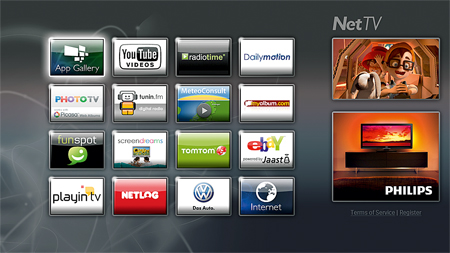
Philips PFL7965T: Picture quality
Even a daytime-TV staple like Cash in the Attic looks vibrant – no mean feat in itself – and given an authentically high-quality broadcast to deal with, the 50PFL7956T is capable of really impressive results.
Contrasts are strong, detail levels are extremely high and motion is generally unflustered. Tricky movement can induce a little hesitancy, but on the whole this is a composed watch with the kind of hyper-realism that only Philips seems capable of.
There’s a similar level of detail and insight on show with a switch to DVD.
Upscaled images from a copy of Hanna include more picture noise than we’d like (which we reckon is the trade-off for the prodigious levels of detail on show), and there are undoubted issues with motion, but contrast, skin-tones and –textures, and apparent depth of field all impress.
At the top of the quality shop, Blu-ray images look an absolute treat. Our copy of War Horse revels in extensive, clean and detailed contrasts between black and white tones, and offers greater overall levels of detail than any similarly priced TV we’ve seen so far this year.
Motion is handled confidently with all but the most maverick of camera moves, and the impression of depth the 50PFL7956T is capable of generating trounces even the best of its rivals.
Picture noise is negligible, edges are crisp, and the colour palette is wide-ranging and natural.
And, of course, the film is delivered in full, filling the screen with no black bars getting in the way (though the Philips is, of course, scaling the content of the disc to fit its 2560 x 1080 resolution).
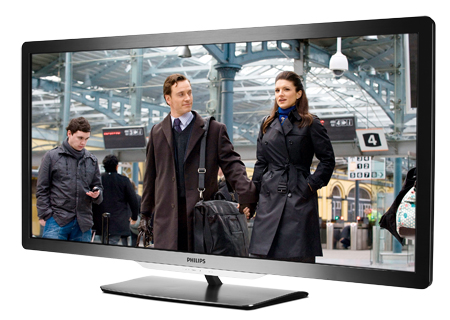
Philips 50PFL7965: Gaming and 3D
We’ve been enjoying The Witcher 2 on the Xbox 360 lately, and played on the Philips it looks bright, colourful and superbly detailed.
As a gamer’s TV it suffers a little from the cleverness of its own processing: there’s discernible button-lag when playing. With the tech switched off, though, motion gets more than a little shimmery and approximate.
It’s possible to effect a fairly workable compromise, but at no point is the 50PFL7956T entirely happy with a console attached to it.
With our lightweight 3D glasses in place and a copy of TT3D: Closer to the Edge spinning in the player, the benefits of the Philips’ passive, ‘Easy 3D’ configuration are obvious.
As we’ve seen when reviewing LG’s recent 3D TV offerings (the Korean giants are by far the most vocal advocates of passive 3D), watching 3D this way is gratifyingly easy on the eyes and eliminates flicker almost entirely.
Yes, the resolution of 3D pictures is effectively halved compared with active-shutter sets, but the Philips generates such lavishly detailed images it’s scarcely an issue.
Images are bright and colourful, motion is gripped tenaciously, and the 3D effect, undoubtedly aided by the Philips’ Ambilight-assisted facility with perceived depth, is pretty dramatic.
Philips 50PFL7965T: Sound quality
The company is claiming a total of 34W to drive the 50PFL7956T’s speakers, as well as referring to something called ‘incredible surround’ as one of its audio options.
There’s no denying the expansive nature of this set’s sound, but it’s entirely lacking in presence below the midrange, and what information there is sounds rather weedy.
Once again, we strongly suggest you try a soundbar as the very least you should to bolster the sound of your nice, new (and expensive, let’s not forget) television.
While we’re finding fault, we need to point out that our 50PFL7956T suffered from minor, but definite, backlight bleed in its bottom-left and top-right corners.
It all-but disappeared when the screen was showing a picture, but at the very least it would mean a trip back to the retailers…
Verdict
Fundamentally, this is a TV for those who watch a more-or-less exclusive diet of HD films.
It’s a fine telly, of course, but there’s little enjoyment to be had in watching your soaps with black bars to the left and right of the picture. It’s almost indecently satisfying for watching movies, though – and, let’s face it, it’s a pretty cool bit of décor, too.
What Hi-Fi?, founded in 1976, is the world's leading independent guide to buying and owning hi-fi and home entertainment products. Our comprehensive tests help you buy the very best for your money, with our advice sections giving you step-by-step information on how to get even more from your music and movies. Everything is tested by our dedicated team of in-house reviewers in our custom-built test rooms in London, Reading and Bath. Our coveted five-star rating and Awards are recognised all over the world as the ultimate seal of approval, so you can buy with absolute confidence.
